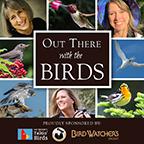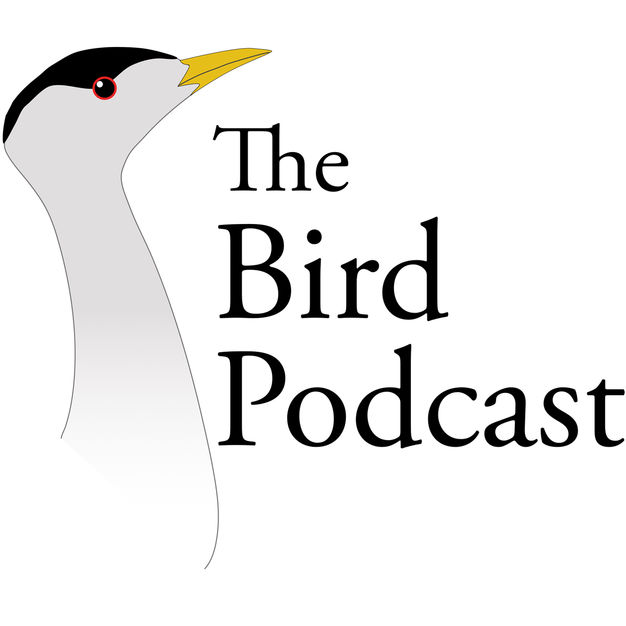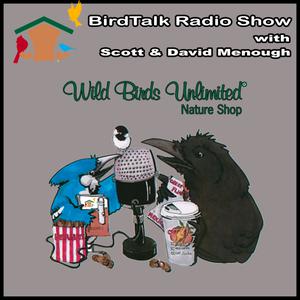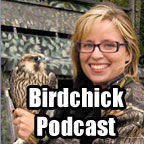
Grumpy Old Birder
Bo Beolens
Grumpy Old Birder rants about the world of birdwatching, wildlife conservation and more...
- 4 minutes 23 secondsGOB 100 – Birding
Birding
This article first appeared in Birdwatching Magazine February 2018
Like my childhood self I am in awe of the vast blueness of sky over the summer reed-bed. Is this ineffable depth, breadth and beauty God? Unknowable and visceral, my sated awe becomes tranquillity.
But not silence, as Gaia’s breath is ruffling reed-stems and bush leaves, lullaby-like but not soporific. Like a distant melody drawing forth a vague memory of music, an ear-worm that awakens attention. Beneath it a deeper beat of insects buzz.
Momentarily my eyes are drawn to the flutter of a butterfly never settling for inspection. Bombastic bees bounce and drift, bounce and drift, bounce away as my eyes are taken by the pop-up perching of streaked perfection ruined by scatter-brain song. The Sedge Warbler drops down in an instant. My vision is drawn across the straw-yellow sea of reeds. Periodic Reed Buntings punctuate the scene. If it stays up in view it self-identifies punching out song to proclaim its maleness.
The melody is building, but there is a contrapuntal chorus breaking into awareness. Marsh Frogs are making their maleness known too. Like a cough in the concert hall a Moorhen’s unnecessary alarm momentarily distracts, but is forgiven as the musical complexity captivates. As if a contralto’s aria is unexpectedly performed at full volume a Cetti’s Warbler whispers across seven fields. Subtle by their distance Jackdaws chack and jack like an audience murmuring appreciation.
Steady strong flight creeps into the eye corner gliding across the pools and ditches between beds. Sun glints on a golden headdress as she flies in to relieve the calico male from nest duty. He doesn’t harry but soars preferring another hunting ground. Mrs Moorhen skitters again fearing for her clustered brood. Plovers take to their flapping flight as duty calls them to see-off the predator. Obscured before they flew, a lone Greenshank dips and struts elegance, wading majesty. The Sandpiper peaks from behind a bulrush to bob and bow across the mud picking invisible flies where they use a puddle’s meniscus to consider reproduction.
Over their heads a life-long couple hover and dive together. White-wings folded she settles on the mud to receive the silver fish he offers, an hourly tribute to her fertility. Having danced they drift away to couple on a safe islet elsewhere.
Their flight takes my eyes back to the never empty summer singing sky-blue. Hirundines have gathered while I supped on nature’s grounded feast. They throng and turn invisibly high, or water skim and skirl head high each shrill call a thrilling summer proclamation. Massed they suddenly starburst like a rocket as summer’s scimitar winged hunter dives for fast food. Luckless the Hobby peels away to soar again with seven fellows circling and sating their hunger on the midday Odonata hatch.
The high sun’s warmth has hatched thermals and Buzzards circle as they drift across the scene. The kettle slowly steams across the sky until even binocular enhanced views are too dim.
Drawing back again to the high blue I see true summer – Swifts are teaching all others how to fly. There can be nothing more truly sky-borne than Swifts. All else seeks to emulate the mastery they demonstrate. Fledged into the sky they know only air until adulthood forces their too-short feet into cliff crevice or roof space. Is it my soul that soars with them in religious rapture or just ornithological euphoria? They are the crescendo’s end, the peak of perfection, an avian art-form.
Tired eyes may search out the dapper dress of Bearded Reedlings or summer seeking ears my listen for Turtle Dove purrs or Cookoo calls, but the high ridge has been conquered when the Swift summit was reached.
Hear the Podcast:
https://grumpyoldbirder.com/wp-content/uploads/2018/02/GOB-100-Birding-Edited-LR.mp37 February 2018, 8:43 am - 3 minutes 56 secondsGOB 99 – Tree Huggers & Tree Muggers
Tree Huggers & Tree Muggers
This article first appeared in Birdwatching Magazine January 2018
Who could resist running one’s hand along the skin-smooth bark of a beech tree or hugging a hornbeam? Can anyone doubt the primal pleasure of hearing the wind ruffling the leaves of a poplar or knowing of the reassuring longevity of a craggy old oak? Well the answer turns out to be the municipal muggers who are more concerned by possibly litigation than certain deforestation.
In a week where I received an invitation from the London Borough of Waltham Forest to the opening of their new nature reserve, I also read about the utter foolishness of another London borough. It seems Wandsworth council have plans to remove an avenue of 150-year-old chestnut trees on Tooting Common. Is the heartwood rotten or have our increasingly frequent storms damaging them? The answer is a resounding no! So why are 51 magnificently mature trees being replaced by 64 saplings? It’s not that they are dangerous, but that they might become so. One fell over and some others need pruning. The council culling is the worst sort of euthanasia, chopping down the hale and hearty because ‘THEY MIGHT ONE DAY GET SICK’, makes me shudder as I approach an age when Wandsworth might consider me ready for the scrap heap, just in case I go gaga and become a financial burden.
Are they alone in their municipal madness… not a bit of it. In Sheffield, the last batch of mature trees in the borough will probably have been under the axe by the time you read this. Why? Because of a ridiculous private contract that puts the maintenance cost of mature trees as far greater than that of saplings.
There is something desperately wrong with a society that puts a lower value on a massive and ancient oak than they do on a small, non-native sapling. Town trees are not just pigeon perches, they are a lifeline. Every survey ever undertaken shows how nature can go a long way to putting right what we get so wrong whether its urban pollutants or the destroying of souls by turning everything in our environment into concrete. We need trees for our physical, mental and spiritual wellbeing. Even the most arcane accountant must put a huge financial value on arboreal assets.
Us ordinary citizens are up in arms whenever trees are threatened. It doesn’t matter whether you are a woolley-minded liberal, a dyed in the blue wool tory or a red and ragged socialist, everywhere real people really care about trees in a way that is almost druidic. There is a little ‘green man’ in us all no matter how urban we have become. But this community upsurge alone will not save the day.
We need to legislate. We cannot afford as a society to be ludicrously litigious. The reasonableness of common-sense is being replaced by the t’ching of cash when we can cover up our own recklessness by suing ‘the authorities’. Individual judgements cannot dictate to society as a whole in this way so we need to enshrine in the statutes a greater degree of personal responsibility. Don’t go out in a storm then sue the tree owner when the gale brings its branches down on you, stay in doors! When a conker falls on your conk its an act of nature not the fault of an elected official who recklessly let the horse chestnut tree stand.
What is more important to defend, the health of the nation or the liability of those whom we elect?
To paraphrase the old ode… I think that I will never see, a poem lovely as a tree. If we let the council axes fall, we’ll never see a tree at all!
Hear the Podcast:
https://grumpyoldbirder.com/wp-content/uploads/2018/01/GOB-99-Tree-Huggers-and-Muggers-Edited-LR.mp36 January 2018, 9:06 am - 3 minutes 46 secondsGOB 97 – Garden Cities
Garden Cities
This article first appeared in Birdwatching Magazine November 2017
I watched the World Athletics Championships Marathon wending its way through the historic streets of the City of London and was struck by two things over and above my dual admiration and horror that anyone can run more than twenty-six miles in a couple of hours, and that anyone would want to. Surely a gentle stroll (or in my case lurch) a few meters down a track to a bird hide would ease their stress levels and keep them fit in heart and soul if not in body.
Having spent a lot of my working life in the Capital I was struck by its fine architecture and reminded of the splendid street names. These days, new estates end up with the boring names of boring councillors or some twee theme like garden flowers or Scottish counties, who would name a road Threadneedle Street today, let alone Cold Bath Lane, or a local favourite of mine Poor Hole Lane, commemorating the pit hapless serfs were dumped into having fallen foul of the plague.
As we are increasing cut off from the country one would expect us to become more ‘urbane’ instead of having all colour drained from our brains.
And that was the second thought that struck me as TV drones gave me a bird’s-eye view of the super fit African runners leading the rest… the only green on view was the colour of the Ethiopian’s vests! Pan out and, of course, London sports some wonderful parks, a few even being wildlife havens. At street level a bistro or two has some topiaried box and pubs flourish an occasional hanging basket, but I spotted just two rooftops that sprouted greenery. One was clearly bedecked in a sedum blanket and another had one corner with some turf and a few potted trees surrounding what I assumed was the Directors’ roof retreat of some merchant bank or insurance company.
We are being left behind the rest of the world in imaginative planting.
One of my first overseas trips was to see family in New Zealand with a stopover in Singapore. Even then that city was one of the greenest I’ve seen with every street an avenue, every unpaved yard a shrubbery and every hanging walkway a hanging garden with vines spreading along the walls and almost reaching the traffic below. Now this city of gardens strives to be a city within a garden. Despite its teeming millions, traffic congested streets and towering habitations it seeks to bring the country back into the town.
Where are we who pride ourselves of being the epitome of urbanity in humanity? A cold, grey blot on the landscape. While one hand tries to diminish exhaust fumes and motorised congestion the other hand has just the barest suggestion of life enhancing foliage. All those flat roofs could be a million lungs of sedum, grass or greenery. If Milan in the heart of a country that we distain for its lack of wildlife protection can create an incredible vertical forest on residential towers, surely, we could manage a bit of turf on the city’s flat roofs?
Best kept villages may encourage household gardeners and Britain in Bloom might muster municipal horticulturists to turn roundabouts into floral tributes but, as a nation we need to do so much more to bring country into town and use our redundant rooftops to be natural air fresheners.
Who knows, a few more plants might feed a few more passerines, encourage a few more pollinators and fix noxious discharges before they drift into the food chain, or from lining our children’s lungs with lead.
Hear the Podcast:
https://grumpyoldbirder.com/wp-content/uploads/2017/11/GOB-97-Garden-Cities-Edited.mp311 November 2017, 11:52 am - 3 minutes 59 secondsGOB 96 – Tales of the Unexpected
Tales of the Unexpected
This article first appeared in Birdwatching Magazine Autumn 2017
Outside a summer gale is rocking every bush in my tiny garden… this seems to be an inevitable consequence of sweeping the patio and clearing all the dropped leaves from my pots. But, despite the weather it’s a red-letter day as we have had a new garden tick after 18 years!
Our garden could fit into a couple of decent-sized rooms, but we’ve packed it with pots, and crammed it with every bird and bee attracting plant we can. This includes a cherry tree planted purely for their benefit. Our crop rarely gets fully ripe before its swiped by avian interlopers. Oddly our ring-necked parakeets stick to the seed feeders and the apples we supply leaving the cherries alone. Usually, half a dozen different blackbirds pop in and polish off the cherries. But our red-letter visitors for the last couple of days are a pair of Mistlethrushes. I’ve seen an odd one over the years on a neighbour’s roof but nothing has tempted them into our patch before. It’s been a joy to watch them fly off clutching a half-ripe cherry in their beaks, presumably to the local park where we see half a dozen in the winter.
I assume that they can manage to take the flesh and leave the stone; I certainly hope so as they are surely destined for their brood.
Most of the fruit we produce is eaten during late Autumn or Winter. Pyracantha is so laden one day that the bush threatens to tip over or the branches break, the next its under siege and a few days later completely stripped bare by the blackbirds and, if we are in luck, winter thrushes. Cottoneaster, Elder, Ivy and Honeysuckle all become fast food diners and the grape vine and blackcurrants disappear as if by magic.
We put out currants and sultanas which get eaten by a variety of birds even over-wintering blackcaps, so this year we have upped our game with a gooseberry, raspberry and blackberry bush squeezed into the few gaps in pots or soil… in the hope we can feed more birds and even attract a few new summer species, maybe the ones that, unobserved, devour the wild strawberries that self-sow in half the planters.
It’s one thing keeping the feeders topped up, it’s another to make sure we are growing natural food for them, but even more important is attracting the insects that pollenate and those that are also part of the food chain.
It’s amazing how much pleasure one can derive from just watching mason bees and leaf-cutters sealing the cells of our bee-houses. Butterflies and beetles, moths and damselflies may be harder to ID on the wing than birds, but they too lift the spirits in summer when their flight sights and sounds fill the gap left by busy bird parenting.
But planting borage or lavender is not enough, we need to ban all chemicals from the garden, pond and patio and bring heart back with blood and bone and good old-fashioned manure. Think how big the nature reserve could be if all gardens were free of the chemical cosh that too much agriculture uses. Moreover, we need to lean on the municipality too to stop our parks being polluters.
The more that mad municipalities and over-zealous park-keepers strip undergrowth and mangle hedgerows and grass verges the more we have to do to bring the hedgerows and verges into our gardens. I let the plants spread in bird droppings take hold where they spring up so several pots in hidden corners sport elderberry bushes and I’m hoping hawthorn or blackthorn gets brought in in a similar fashion.
I bought a blackberry bush the other day at the supermarket. It’s thornless which is a bonus, but I’m sure the blackbirds and blackcaps won’t mind, and you never know, they might even leave us a few berries.
Hear the Podcast:
https://grumpyoldbirder.com/wp-content/uploads/2017/10/GOB-96-Tales-of-the-Unexpected-Edited.mp37 October 2017, 4:01 pm - 4 minutes 10 secondsGOB – 95 Tales of the Riverbank
Tales of the Riverbank
This article first appeared in Birdwatching Magazine October 2017
Boxing is brutal with many more losers than winners. One might argue it saves tearaway teenagers from a life of crime, but, in a progressive society it should be banned. I would, on balance, support a ban, despite the fact that I love to watch ‘fight night’ and Mohamed Ali remains my all-time sporting hero.
Shooting for pleasure crosses that line as the object is to kill not win, otherwise shooting clay pigeons would be the chosen, humane alternative. What bothers me most is the effect it has on ‘sporting’ humans; desensitising them to killing, let alone its effect on wild animals. One can make a strong case in support as, where shooting of released game birds goes on, the land is often enhanced for other wildlife. Pheasant shoots in my locality, managing the land for gamebirds, rather than intensively farming it, has led to some of the best raptor watching in England with high densities of small mammals and passerines.
Of course, the same cannot be said for grouse moors or Scottish deer-stalking estates, where the land is managed badly for competing species whether they be predators or rivals.
Angling is hard for me to be dispassionate about as I occasionally indulge. Like many a wildfowler, I enjoy it as much for the wildlife watching as for the fishing. It is bizarre that I find it so hard to outwit an order of animals supposedly many hundreds of millions of years behind me in brain power! On my last outing, the fish won 10.5 to 2.5. I ‘missed’ ten bites, lost one fish in the weeds and caught just two (obviously gently returned to the water). I cannot justify my actions, I enjoy the ‘hunt’ aspect, just as one enjoys hunting for new birds. I dream of hooking a fish large enough to test my strength (although these days that doesn’t have to be that big!). I’d miss the possibility of fishing, but cannot, in all conscience defend it. I cannot lie to myself, fish feel pain and being hooked in the mouth must be nasty. Ironically, my last outing followed a tooth extraction so I did empathise.
That lakeside outing prompted this month’s article.
I rarely rise early to bird nowadays, just like I almost never twitch. I don’t go to reserves because there is some reported rarity, but rather I decide where I want to go and then just enjoy what’s there. In high summer this may well be insects or in spring it might be hares. However, the lake where I fish has one corner spot that I favour for its shade and tranquillity and I know it is popular, so I had to be there before 7.00am to stand a chance of occupying it.
In those few hours rooted to one place my eyes often failed to focus on my fishing float because there were so many distractions. Two pairs of reed warblers flitted from the reed stems to a bush three feet away from me. Yaffling green woodpeckers flew over. Cetti’s called and occasionally popped out from the reeds. Moorhens and ducks paraded their fluffball families for me. Twenty minutes after I set up, a year-tick kingfisher left the bankside vegetation next to me where it had sat unnoticed, streaking by a foot from my rod tip. A frog swam by kicking out his legs lazily then sinking into a weed-bed. Overhead a Marsh Harrier began her day’s hunt. As the sun strengthened Small Heath and Gatekeeper butterflies took to the wing. A common Blue Damselfly landed on my float, but was dislodged by a Black-tailed Skimmer living up to its name. Like a cretaceous monster an Emperor Dragonfly lorded it over the lake.
One might argue that a bird-hide sojourn would give one the same experience, but angling has me just quietly sitting among nature’s glory.
Hear the Podcast:
https://grumpyoldbirder.com/wp-content/uploads/2017/09/GOB-95-Tales-of-the-Riverbank-Edited.mp312 September 2017, 9:59 am - 3 minutes 59 secondsGOB 94 – Crop Rotation
Crop Rotation
This article first appeared in Birdwatching Magazine September 2017
Half a century ago, a Malaysian friend told me of his dream. He wanted to write, but first needed to earn enough money to buy a small plot of land where he would dig a pond for carp, plant breadfruit trees around it and keep pigs. He would always have water, and food, having carp, pig meat and breadfruit; his dream was of agricultural perpetual motion. Breadfruit would fall from the trees for the pigs to eat, pig manure would keep the trees healthy and shovelled into the pond would feed the carp, any leftovers from the carp would be quickly eaten by pigs!
Not my idea of heaven, even if the breadfruit trees held Broadbills and Bee-eaters, I don’t eat meat, don’t like breadfruit, don’t really fancy shovelling pig dung under the hot sun and the only time I ever ate carp it tasted like mud with bones in! However, it is an ideal sustainable life-style.
Until the industrial revolution every country had its version, here it was a mix of crop rotation, irrigation or drainage and the use of animal and human ‘night soil’. Until relatively recent times, sewage was a blessing not a problem, and land was kept in good heart by its recycling. Pests were kept in check by the continuous switching of crops around the fields. I’m not trying to bring back the night soil men; untreated human waste can carry disease and intestinal worm eggs, but ‘sludge-management’ as it’s called, would save the country millions in imported fertilizer and save the earth from being despoiled and the seas vacuumed clean of all life. However, sludge management would need an upgrade as micro-fibres build up in it from our washing of fleece jackets and microbeads of plastic from exfoliants. Their effects on the land is uncertain.
Sorry if you are enjoying breakfast, but what is it with our use of our toilet bowls as waste disposal units? Eco-conscious city dwellers recycle their Merlot bottles, hang their Harrod’s ‘bag-for-life’ in the crook of their arm and sort their Daily Telegraphs into the paper bin with their shredded restaurant receipts and unpaid tax demands. So why can’t they resist the lure of the flushing maelstrom, but must add to its turbid waters that which cannot rot, so half the country’s sewers are clogged with cotton buds and less mentionable non-recyclables! All too often of course, these eventually flush into our increasingly polluted sea.
I live in ‘Cauliflower City’. Here the fields crow continuous cabbages. Half the crop is rejected by the supermarkets and ploughed back in. Within weeks the same field sports more of the same. When the plough is in action the corvids, gulls and pigeons follow more in hope than expectation. Thereafter, the agri-desert is even devoid of doves.
If you add the cost of fertilizer, herbicide, pesticide, wasted seed and unbought crops together the margins are too tight to sustain individual farms, just the combined ‘units’ of land held by massive businesses. Turning back the clock to rotating crops is a no brainer… millions could be saved on the chemicals used to scour land of disease and the return to a healthy, albeit man-managed eco-system would go towards our own well-being. Stepping back to centuries-old methods would not just see wildlife return, but sold direct to local shops would see farming profits return too.
It is often said that to survive farms have to grow in size, cover every type of agriculture and diversify into other activities. But I submit that a backwards step could actually be the key to progressive farming!
Hear the Podcast
https://grumpyoldbirder.com/wp-content/uploads/2017/08/GOB-94-Crop-Rotation-Edited.mp311 September 2017, 10:11 am - GOB 93 – Rubbish Party
Rubbish Party
This article first appeared in Birdwatching Magazine August 2017
The ‘Rubbish Party’ won a council seat somewhere in Scotland in the last council elections. If you think this appellation is an unprecedented admission of political ineptitude, let me disabuse you; their main policy is cleaning up local litter.
Litter, as I have ranted before is an issue of utmost concern directly or indirectly responsible for the death of millions of animals world-wide from plastic bags swallowed by cetaceans to grebes strangled by fishing line.
Ironically our massive trash heaps are one reason why gulls became familiar to the most inland of sites. We still send half a billion pounds’ worth of food to landfill, so gulls, corvids and rats have plenty to recycle. The best of us create very little waste and compost our peelings or send food scraps to the bio-digester. But most of us buy it, forget it, then dump it in the bin fooled into thinking ‘sell by’ means ‘die if you eat after this date’. Indeed, many of us ‘err on the side of safety’ and scrap anything even approaching the meaningless ‘best by date’. This viscous cycle of silly sell-by dates, consumer paranoia and supermarket stupidity in selling overlarge packs with ‘bogof’ offers keeps the heaps piling up and the farmer’s prices tumbling. The latter faced with the ‘need’ to offer uniformity for packaging not only add to the ever-growing pile of what is grown but not eaten, but they use more chemicals, maximising yield by minimising loss to wild creatures great and small.
So, gulls dine out on doughnuts and peck at old pizzas risking life and limb from sharp cans and entangling plastic. Learning, of course, that such bounty is available via the shortcut of tearing open black sacks and scattering our household waste down the street before the bin-men can collect it.
As bin collections become less frequent and certain items banned we seem to be replacing the family visit to old friends with an outing to the re-cycling centre. There we unload the garden grass cuttings, bung the technologically surpassed telly and cart our cardboard to the giant paper bin.
If we have indulged in DIY, or have an old freezer we hire a trailer which we have to leave outside the centre and drag stuff in by hand. Why? To stop the commercial exploitation of this domestic service. Apparently, white van men by the million would sneak in their old sofas and builder’s rubble and do what? Recycle them without paying for the privilege! Can someone please explain to me the logic of this municipal madness!
Two miles from my ‘household’ recycling centre is another ‘commercial’ one where companies and lone traders are charged to get rid of the guts of a refurbed house, or the unsaleable leftovers of a house clearance.
Has any local authority ever compared the revenue generated against the cost of fly-tipping? The ‘black economy’ is peopled by those who pay no tax, drive un-insured, un-roadworthy vehicles – do the local authorities really believe that they will develop a conscience and pay to dump trash? The ONLY reason people fly-tip is to avoid paying.
You may wonder what sparked this diatribe apart from righteous indignation about the despoliation of what passes for wilderness in our over-urbanised land. Well, for years I’ve used a lay-by on a country lane as a raptor watchpoint… I can sit in the car out of the elements and scan the skies over wetland and shoreline. Or I could until the farmer decided to fill it with huge containers, to stop the idiots who regularly heap detritus there!
Hear the Podcast
https://grumpyoldbirder.com/wp-content/uploads/2017/07/GOB-93-Rubbish-Party-Edited.mp38 September 2017, 10:00 am - 3 minutes 45 secondsGOB 92 – Old Gits & Spoilt Brats
Old Gits & Spoilt Brats
This article first appeared in Birdwatching Magazine July 2017
Rant Warning! Why on earth would you be bothered about disability access to nature reserves? It’s obviously not much of a problem as just about every hide you’ve been in has a wheelchair slot and you hardly ever see any birders in wheelchairs; if they can’t make the effort, why should you? I mean, the only bloke you ever see in the wheelchair slot is some rude old git who doesn’t even answer when you speak to him. All this access rubbish is just part of the politically correct nonsense that plague’s our society. The disabled should stick to blocking Post Office queues and whining about everything. They are almost as bad as the muesli brigade driving round in Chelsea tractors, round in their Berber and Northern Exposure gear, dragging noisy brats into the hides scaring off anything worth looking at and groaning on about how lovely larks are and isn’t that swan pretty. I mean what’s that all about?
Well my friend, let me enlighten you. Those middleclass ramblers with brats are trying to get kids to appreciate nature before it disappears under concrete and tarmac. These urbanites (like most of us) may not know terns from tertials, but given time they just might. That’s if the kids are put off forever by some misery with a long lens and a bad attitude shushing them for getting enthusiastic. Chances are they will have trouble seeing anything out of the hide as viewing slots and elbow shelves are too high for them and the low-level ones in the ‘wheelchair’ space has no seating.
By the way, that rude old git is me. I am by nature curmudgeonly, but the ‘rudeness’ is because I haven’t put my hearing aid in so never heard you speak. I probably have my hearing aids on a setting that lets me hear bird song for the first time in years!
The wheelchair slot is an increasingly common ‘concession’, and sometimes is even fit for purpose with extra knee room, however, mostly it’s just a gap between fixed benches with a lower window. Not so much a concession as a bone thrown to starving dogs. Seemingly an act of kindness, but bringing a sense of benevolence to the bone thrower. The hide has a wheelchair slot and a ramp – what more do you want!
I’m going to tell you, not set back the cause like one TV presenter by claiming that making concessions to disabled people is a threat to wildlife! We don’t need extra paths or closer viewing, but making what is there better for everyone!
I’m an example. My front is curved by over indulgence, but my back is curved by fate. I have to prop my elbows up higher than is comfortable so can’t raise my bins. If the fixed bench is too far away I have to balance on my coccyx or not lean on my elbows. If the benches were moveable and the slot heights variable I, kids, elderly folk and a whole range of non-standard birders would be better served. If paths had periodic benches or simple perches I might be able to make it further than the first hide on a good day with the wind behind me.
Some disabled people must use wheelchairs, and they need concessions… the majority of people with mobility issues need a lot more thought! Hide facilities are not ‘one size fits all’ unless you are six feet, fully fit and very flexible. The vast majority would benefit from variety. Good design costs no more in cash, just a lot more in empathy and brain use!
Why should you care? Because you were young once, will (if you are lucky) get old, are likely to suffer some mobility restriction even if temporary and may, if you have a better attitude, get to breed small people of your own!
Hear the Podcast:
https://grumpyoldbirder.com/wp-content/uploads/2017/06/GOB-92-Old-Gits-Spoilt-Brats-Edited.mp330 June 2017, 12:42 pm - 3 minutes 51 secondsGOB 91 – Birding Doldrums
Birding Doldrums
This article first appeared in Birdwatching Magazine June 2017
Picture this, everyone around you is just getting into their shorts and sandals, beaming with bonhomie and generally frolicking in the sunshine and you stare out at the blue skies with a miserable face.
Spring is over and it’s not yet autumn and the rest of the world celebrates while you slump into the shallows of despond.
What’s wrong with you? Get out there and enjoy the verdant foliage and lush woodlands… except, of course, the mass of leaves hides most birds from view… nothing much new is turning up on your patch and the twitching media are hushed except for news of cetaceans, Odonata or Lepidoptera… if you wanted to know about the latter you would be a bugger not a birder your internal dialogue concludes as you sigh inwardly.
Even when you do go out to stretch your legs, or the dog’s, everything is confusion. Mega tick waders first glimpsed turn out to be young redshank… weird warblers and funny finches turn out to be newly fledged old hats. Apart from the faithful blackbirds and raucous Cetti’s warblers most of the birds cannot even be bothered to serenade you as they stay up to all hours grabbing grubs to stuff the mouths of their over demanding youngsters.
When you do get back the will to bird it is nipped in the bud by a spouse or relative expecting you to chuck another prawn on the Bar-B or gather a tribe of gosling-like children and fiddle about in rock pools or exhaust your bank manager’s patience to afford a visit to some madhouse of a mega park where you are expected to enjoy being endangered by fast moving Ferris wheels or lunch hurling switchbacks.
Even the pub is off limits as the garden is filled with nestlings and the lounge bar with musically challenged fledglings who think volume is the whole point of music. Your mates are not available for sneaky outings as they too are required to be grandparents, parents or willing participants in the living hell that is a family holiday in Blackpool, Benidorm or Bournemouth.
Cars that should be parked in the shade of Titchwell or Leighton Moss are nose to tail on the M forty something or the A-road to ferry ports.
Courage mon brave, all is not lost! If you can sneak away from Southport sands or Terra Mitica’s grasp there are birds to be had. Just away from the sands are mudflats and inland are marshes, on the fringes of Benidorm are Black Wheatears and Hoopoes.
If dad looks after the kids you can sneak off for an hour or two of tranquillity, if mum takes the reins maybe you can slip off to a cool hide and test your ID skills out on all those fluffy balls of wader chickery or just enjoy the breeze and baby birds.
Late on a summer evening when the air is cooling over the marshes and the still pools are alive with insect hatches you can watch the wonder that is the Swift as it ploughs through the air sucking up the invertebrate soup with the majesty of the most birdy of birds. If you are in the right place you can soar with the hobbies as they take out drifting dragonflies or chase hapless sand martins. There are still quiet lakes where Spotted Flycatchers ply the sky with their constant looping from their perch into the midges and back to their perch again. The luckiest of us may find a quiet Scottish moor and listen to the clapping wings of a Short-eared Owl’s display or perhaps an East Anglian pine forest clearing to see Goshawks soar, Woodcock rode or Woodlark sing. Stay late on the lowland heath and watch dusk broken by the white flashes of a nightjar’s wing or lay awake in the small hours by a scrubby hillside where nightingales still sing.
Hear the Podcast:
https://grumpyoldbirder.com/wp-content/uploads/2017/06/GOB-81-Birding-Doldrums.mp329 June 2017, 10:07 pm - 3 minutes 57 secondsGOB 90 – Snap Happy Birders
Snap Happy Birders
This article first appeared in Birdwatching Magazine May 2017The photo revolution took off when we no longer needed to buy film. When I was given my birthday ‘box brownie’ it took me about two months to use up the first film. 1960’s Eleven-year-olds didn’t take many snaps; when developing the film cost nearly as much as the camera I was never going to be prolific. I remember seeing a wedding photographer with his auto-wind going full blast and thinking he must be really earning it to go through film that fast.
Nowadays the average eleven-year-old takes more pictures in a week than I did in my first year. But like fashion, most shots are ephemera, discarded seconds after they are taken. The rest stack up on iPhones only to be lost forever when the kid gets mugged.
When I started birding only pros took photographs of birds… needing a lot of patience, a hide and a mortgage-financed long lens. Sometime during the last decade birding seems to have become more a photoshoot, with every man and his dog carrying a telephoto lens and digi-scopers using their smart phones. Forums, blogs and mailing groups abound with bird photographs ranging from the breath-taking to the frankly risible. Many seem to have forgotten that high tech and a steady hand may give a crisp image, but doesn’t turn you into an artist.
However, sometimes just having the means to take a photograph turns people into birding paparazzi of the worst kind. Our celebrities are the scarce or vagrant birds migrating in the wrong direction or blown here by a storm. They now get hounded from bush to bush like a drunken starlet in a low-cut gown.
This indefensible behaviour occasionally hits the headlines or even results in unpleasant confrontations, but that’s not the worst of it. Unfortunately, such vagrant birds are probably not destined to live long and most will never home.
What bothers me, greatly and increasingly is that fieldcraft is disappearing along with courtesy and common sense. Everyday birds get pushed off their perches by camera-toting birders. In breeding season I fear for the cuckoos and turtledoves that attract this new breed of shooters.
Last year I watched a camera-toting ignoramus walk the length of a chained-off path to take pictures of a bearded tit. I say ignoramus as he was blissfully unaware that what he was doing was not only bad form but illegal. The path was there for reedbed maintenance not public access and, anyway, such birds are always off limits – disturbing them is more than foolish its birding folly.
I’ve often been asked by non-birders if I take photos. Would they ask golfers if they take photos of golf balls down a hole? Photography is a completely separate activity. Moreover, we need law to enforce the country code, and a ban on cameras in breeding season.
Most birders, who take up photography wouldn’t dream of doing anything to harm a bird, but photographers who take pictures of birds seem unaware of the harm they can do. I recently drove a mile-long reserve entrance track with regular signs telling people to use the car as a hide and stay in their vehicle.
My reward was five short-eared owls hunting together, until two other cars pulled up. One lady hopped out of her car and lent over the roof to take a picture. The other idiot leapt out of his car pulling up the tailgate to get his long lens out. Of course, by the time they were ready the birds had flown and a staff member appeared to tick them off.
Hear the Podcast:
https://grumpyoldbirder.com/wp-content/uploads/2017/06/GOB-91-Snap-Happy-Birders-Edited.mp31 May 2017, 10:06 pm - More Episodes? Get the App
Your feedback is valuable to us. Should you encounter any bugs, glitches, lack of functionality or other problems, please email us on [email protected] or join Moon.FM Telegram Group where you can talk directly to the dev team who are happy to answer any queries.
 Out There With the Birds
Out There With the Birds
 Bird Podcast
Bird Podcast
 Hannah and Erik Go Birding
Hannah and Erik Go Birding
 BirdTalk Radio Podcast
BirdTalk Radio Podcast
 Birdchick Podcast
Birdchick Podcast
 Laura Erickson's For the Birds
Laura Erickson's For the Birds